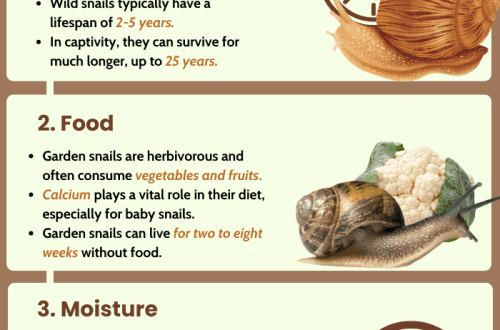
Who are grape snails: growing and breeding individuals
Today, quite a lot of people are engaged in breeding grape snails. There are several reasons for this: despite the fact that their breeding costs almost nothing, you can make good money on such an occupation. Grape snails are a delicacy found in most high-end restaurants. And in order to breed them, you need a small garden plot.
Grape snails: breeding
For the first time grape snails appeared in southern Europe. They began to spread both on their own and with the help of people and spread throughout the world over several centuries. During the Roman campaigns, this delicacy was used by legionnaires as canned food. In the Middle Ages, their breeding became possible – at first, monks bred snails in their garden.
Further, the technique of breeding delicacy snails gained its fame in Europe, Africa and other countries. Gradually grape snail was brought to the territory of Russia.
Who are grape snails?
Grape snail is considered one of the largest in our country. Its body is protected by a strong spiral shell measuring 5 cm both in height and in width. This mollusk is a favorite delicacy of birds, mice, hedgehogs and even predatory insects.
As a rule, the color of a snail shell directly depends on its habitat. So, for example, if a mollusk exists in a dry place, its shell will have a light shade and strength. If, on the contrary, he chooses a humid environment as his habitat, the shell will become darker and softer.
The head of the mollusk consists of two horns that act as its sense organs. The role of the eyes is performed by the horns located on top, and the lower ones are the sense of smell and taste. On the soles of the grape snail there is slimewhich allows her to move smoothly.
Snails, as a rule, do not like the heat, at this time they hide in their “houses” and move little. In hot weather, they are saved by a special film, with which they shield your body. This film allows the mollusk to retain vital moisture for it, perfectly passing fresh air. During rain or heavy dew, when the humidity is high outside, the snails begin to actively crawl.
Habitats of grape snails
- meadows;
- ravines;
- thickets of bushes;
- deciduous forests;
- shaded gardens.
Snails prefer chalk or limestone soil – it is a prerequisite for their existence. During the daytime, mollusks sleep, and at night they are actively awake. It is at night that they prefer to feed.
Mollusks eat quite diversely: cabbage, strawberries, dandelions, raspberries, horseradish, sorrel stalks and many other plants. Snails will be happy to eat both ripe fruits and slightly rotten ones. Even fallen leaves are suitable for their nutrition.
Such snails live long enough, on average 8 – 9 years. In the autumn-winter period, they hibernate, waking up only by April. With the onset of early autumn cold weather, they begin to dig into the soil to a depth of 10 cm. If their habitat is characterized by severe frosts, this depth can be as much as 30 cm.
Breeding grape snails at home
If snails attack your garden with a large army, they will inflict he’s hurt a lot. However, this should not be feared, because in the natural conditions of central Russia, despite their fertility, they reproduce extremely slowly. How do they reproduce in nature?
Grape snails are hermaphrodites, they reproduce sexually. This is happening in a very interesting way. The mollusks are located opposite each other, touching the soles, and shoot at each other with a sharp calcareous formation. After 2 weeks, they can already lay eggs. To do this, they dig a shallow hole in the soil – about 3 cm and equip a nest there. It takes the mollusk about two hours to do this. laying eggs, the snail covers them with earth. About three weeks later, her offspring is born.
At home, breeding snails is distinguished by the methods of cultivation:
- extensive;
- intense;
- semi-intensive.
The extensive growing method involves growing completely in an open area. The advantage of this method is a low budget, the disadvantage is long growing period. Growing in natural conditions is suitable for a private arboretum, botanical garden or park. It is in such conditions that it is possible to exclude the main enemies of the mollusk: rodents, birds, wild boars. In addition, existing in a closed area, individuals will not crawl.
The intensive method involves breeding indoors such as a greenhouse. At the same time, it is necessary to create an optimal microclimate for mollusks and intensive feeding. In this way they grow much faster and ripen (about a year and a half).
Advantages of the intensive method: obtaining a high number of individuals and their eggs, which are called “white caviar”. Cons: high initial costs and high labor intensity. The method is optimal for industrial breeding.
The semi-intensive method is characterized growing individuals in an open garden, creating additional shading and moisture, as well as a good organization of feeding. Thus, snails grow and mature in two to two and a half years, based on growing and keeping conditions.
Advantages of the semi-intensive method: low initial costs, the possibility of growing on a small area, rather low labor intensity. The disadvantages of the method: relatively slow growth and development of individuals (slower than with the intensive method). This technique is quite universal – it is suitable for breeding both in industrial production and in private subsidiary plots.
In the case of growing mollusks by the semi-intensive method in a private subsidiary farm, you can significantly save on feeding them. Dandelions, nettles, burdocks, gout, horse sorrel and other wild plants are suitable for feeding individuals. Also Can you use food waste?, processed fruits and vegetables, leaves. Thus, the semi-intensive method is best for home breeding – food costs will be practically eliminated.





